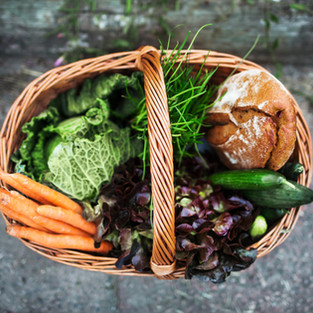Savvy Summer Cooking with a Summer Bounty Vegetable Salad
- Aug 9, 2020
- 3 min read
What makes local in-season produce taste better? Maybe it’s because it’s grown with care and love...

Because our dinner today from a grocery store originates from no less than five countries, we are starting to take a closer look at just where our food comes from. We are realizing that food closer to home in season tastes better because it’s a different product than what you buy in the grocery store. Chef Monique Jamet Hooker, a culinary instructor, cookbook author and expert on local foods from De Soto Wisconsin explains “Food less traveled has a lot more flavor as they are a variety of food that has not been developed to sustain long-distance travel and long storage, meaning it’s real food!”

"Although our region has a short growing season, our dedication to the local food movement has been around long before it became trendy in other parts of the country. Cool-season Cole crops such as broccoli, cabbage, and collards thrive in our cool climate. We also produce over 30 food items within 100 miles of the area that are not weather dependent or made with local hands. We have numerous farmers’ markets bursting at the seams during the late summer and early fall that are gaining popularity. I encourage you to celebrate the fresh clean taste of farm-grown juicy tomatoes until the threat of frost and then move on to sweet fall root vegetables that are so bountiful when the weather turns. You will truly appreciate the different tastes and look forward to them next year again. You might even learn to preserve your own foods so you can savor that fresh from the garden taste in January."

If you look around the world, there are no great local cuisines without great local agriculture. Tasty food comes from producers that love the land and have a commitment to keeping it healthy for generations to come. The big question that crosses most people’s minds in purchasing food at the farmer’s market is should they be buying organic or local that is sustainable? Chef Hooker weighs in on this heavily debated topic “Locally organic whenever possible as it promotes the health of the land and the health of our future generations that will be driving the economy. Then, local as it is supporting the local economy and for every dollar spent, eighty cents stays in the
community versus eighty cents going out of the community. We know for a fact that a healthy community relates to a healthy economy.”

Summer Bounty Vegetable Salad
This recipe is adapted from Cooking with the seasons, A year in my kitchen by Monique Jamet Hooker and Tracie Richardson, (Published by Henry Holt 1997) The original recipe called for Blue Cheese Crumbles, but I omitted them because, in the height of the season, I only wanted the flavors of the vegetables to shine.
Monique says: This is a salad that is truly planned by nature. The vegetables listed are merely suggestions. Take a basket into the garden or to the farmers’ market and pick vegetables according to what is seasonally available. Choose a mixture that complements each other in taste, color, and texture.
10 Servings
Ingredients:
3 cups of water
1 cup each, uncooked:
Broccoli florets
Green beans ends trimmed
Snow peas ends, and strings removed
Carrots, cut into ¼ inch slices
Celery, cut into ¼ inch slices
Zucchini, cut into ¼ inch slices
Yellow squash, cut into ¼ inch slices
Cucumber, cut into ¼ inch slices
Green onion, cut into ¼ inch slices
Red pepper, seeded and cut into ¼ inch strips
6 cherry tomatoes
Dressing:
1/3 cup red wine vinegar
¼ cup chopped fresh parsley
1 Tablespoon Dijon-style mustard
2 Tablespoons honey
½ cup olive oil
¼ cup Gorgonzola cheese (optional)
Wash your hands with soap and water before you start prepping.
Instructions:
Bring water to a boil. Drop the broccoli, green beans, and snow peas into the water for 1 minute. Remove with a slotted spoon and plunge immediately into the cold running water. Drain. Repeat with carrots.
Place the cooked vegetables and the celery, zucchini, squash, cucumber, green onion, red pepper, and tomatoes into a large salad bowl.
To make the dressing, combine the vinegar, parsley, mustard, and honey in a small mixing bowl. Whisk in the olive oil until all the ingredients are well blended. Drizzle the dressing over the vegetables and crumble the cheese on top. Toss the salad gently and let rest for 30 minutes so the flavors blend.
Variations: To turn today’s vegetable salad into tomorrow’s supper, toss any salad left with cooked rotini or mostaccioli pasta. Serve chilled accompanied by a loaf of crusty French Bread.
Food Safe Tip: Gently rub produce under cold running water, scrub firm produce with a clean vegetable brush under running water.
















































Comments